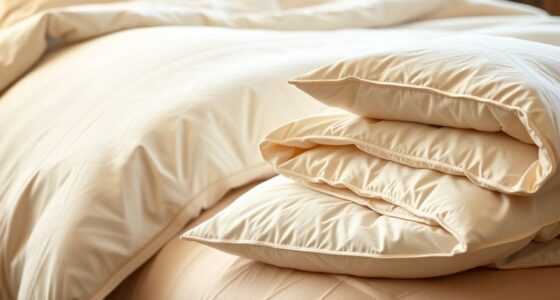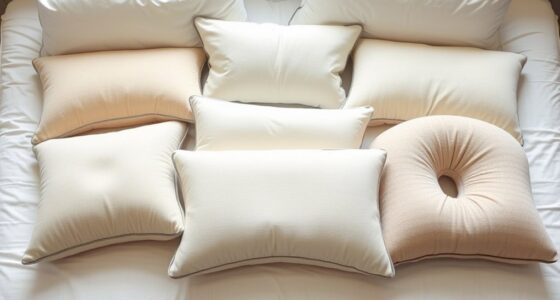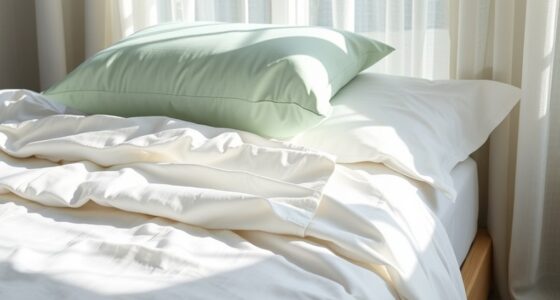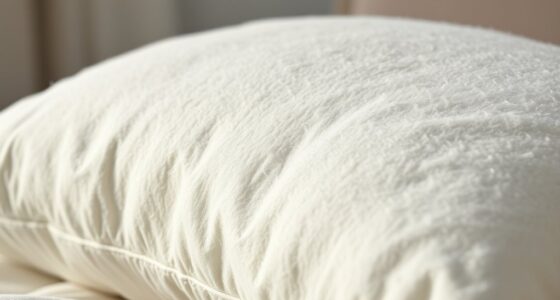To keep your sleep supportive and hygienic, experts recommend replacing your pillow every 1 to 2 years. Over time, pillows lose their shape, supporting ability, and can harbor allergens like dust mites and bacteria. Regular replacement helps prevent neck pain, allergies, and poor sleep quality. Proper maintenance extends pillow life, but don’t wait too long. If you want to learn how to determine the best time for your pillow, keep exploring the details below.
Key Takeaways
- Replace pillows every 1-2 years for synthetic and down, 3-4 years for memory foam or latex, to maintain support and hygiene.
- Signs to replace include loss of shape, uneven filling, odors, stains, or causing neck pain.
- Aging pillows lose support, trap allergens, and reduce sleep quality; regular replacement prevents these issues.
- Proper pillow care and timely replacement reduce allergen buildup, bacteria, and dust mites, promoting better health.
- Choosing the right pillow type and replacing it regularly enhances sleep comfort, spinal alignment, and overall well-being.
Signs It’s Time to Say Goodbye to Your Pillow
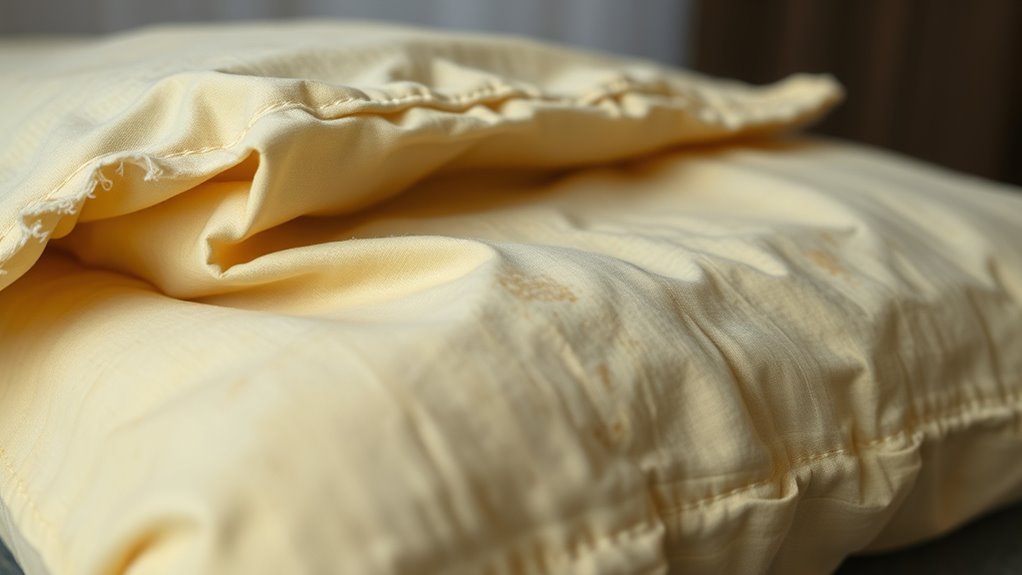
Over time, your pillow can lose its shape and support, making it less comfortable and potentially affecting your sleep quality. Changes in pillow design, like flattening or uneven filling, signal it’s time for a replacement. If you notice your pillow no longer supports your sleep positions properly, you might wake up with neck or shoulder pain. A pillow that doesn’t align with your preferred sleep style can cause discomfort and disrupt rest. Additionally, if you see visible stains, odors, or accumulated dust mites, it’s a clear sign to substitute it. Pay attention to how you feel after sleeping—persistent aches or waking up tired suggest your pillow isn’t providing adequate support anymore. Recognizing these signs helps ensure you maintain quality sleep and avoid unnecessary discomfort. Regularly inspecting your pillow’s support and alignment can help you determine when it’s time for a new one.
Recommended Replacement Intervals for Different Pillow Types
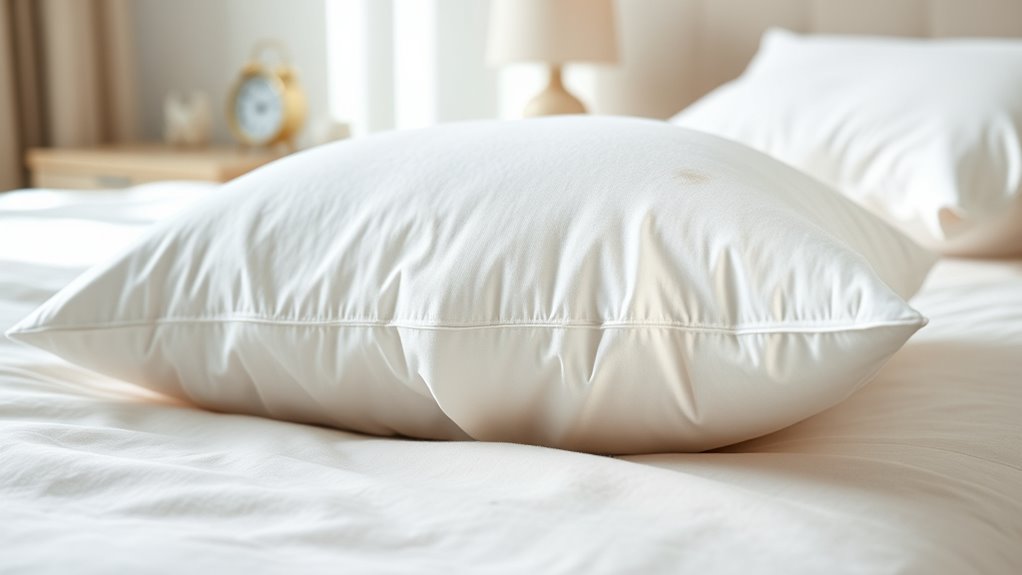
The recommended replacement intervals for pillows vary depending on their type, as different materials wear out at different rates. For example, memory foam or latex pillows typically last 3 to 4 years, thanks to their durability, but may need replacement sooner if pillow color fading occurs or if they lose their shape. Down or feather pillows often last around 1 to 2 years because pillow manufacturing materials tend to break down faster, resulting in flattened fillings and visible wear. Synthetic pillows might need replacing every 1 to 2 years as well, especially when pillow color fading becomes noticeable. Regularly inspecting your pillow’s condition helps determine when it’s time for a replacement, ensuring you maintain proper support and hygiene. Additionally, exfoliating dead skin cells from pillows can accumulate over time, making regular replacement important for skin health.
The Impact of Pillow Age on Sleep Quality
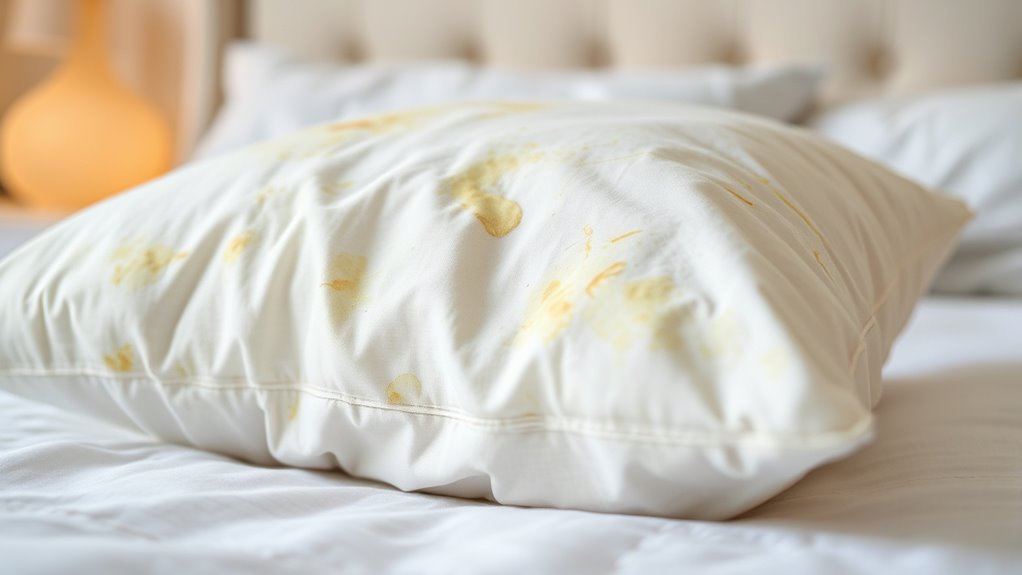
As pillows age, their ability to support your head and neck diminishes, which can substantially affect your sleep quality. Over time, the pillow’s filling breaks down, reducing pillow ventilation and trapping heat, leading to overheating and discomfort. Poor pillow ventilation also encourages the buildup of moisture and bacteria, which can impact your health and sleep environment. An aged pillow can cause you to shift your sleep posture frequently, as you try to find a more comfortable position, disrupting restful sleep. When your pillow no longer provides proper support, you might wake up with neck pain or stiffness. Regularly replacing pillows helps maintain HEPA filtration of the sleep environment, ensuring that dust, allergens, and bacteria do not accumulate, which can otherwise affect your health. Replacing your pillow regularly guarantees that it maintains ideal support, promotes better sleep posture, and keeps ventilation high—helping you wake up feeling more refreshed.
How to Recognize Allergens and Dust Accumulation
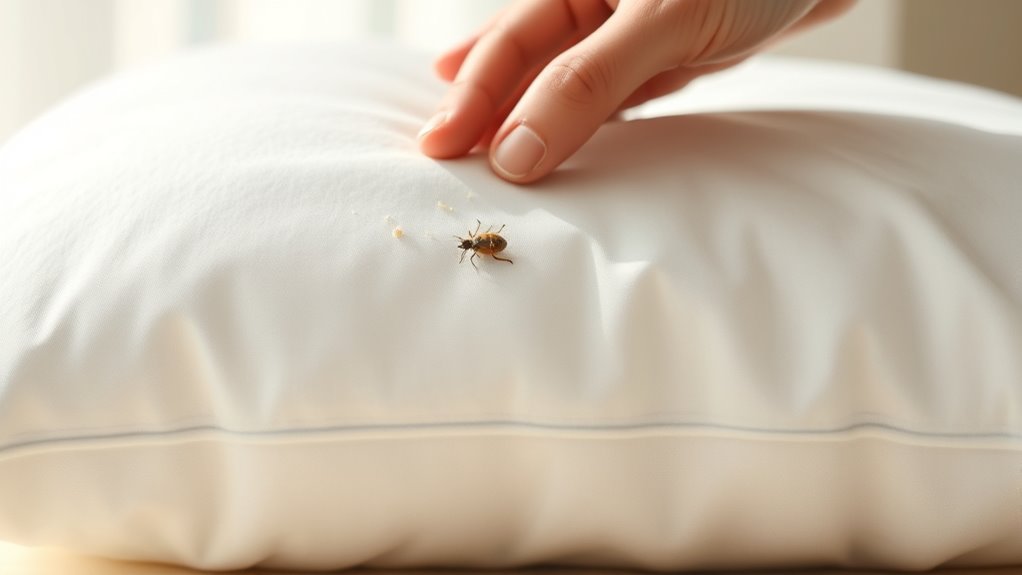
Detecting allergens and dust buildup in your pillow is essential for maintaining a healthy sleep environment. Over time, pillow fillings can trap dust, allergens, and skin flakes, leading to allergen buildup. To recognize these issues:
Regular pillow inspections help identify dust and allergen buildup, ensuring a healthier sleep environment.
- Notice increased sneezing, congestion, or itchy eyes when you sleep.
- Feel your pillow becoming lumpy or developing a strange smell.
- See visible dust or stains on the pillow’s surface.
- Observe a persistent musty odor, even after washing.
These signs indicate your pillow has accumulated allergens and dust. Regularly inspecting your pillow and paying attention to these clues helps you determine when it’s time for a replacement, ensuring your sleep remains clean, comfortable, and allergen-free.
Factors That Can Accelerate Pillow Wear and Tear
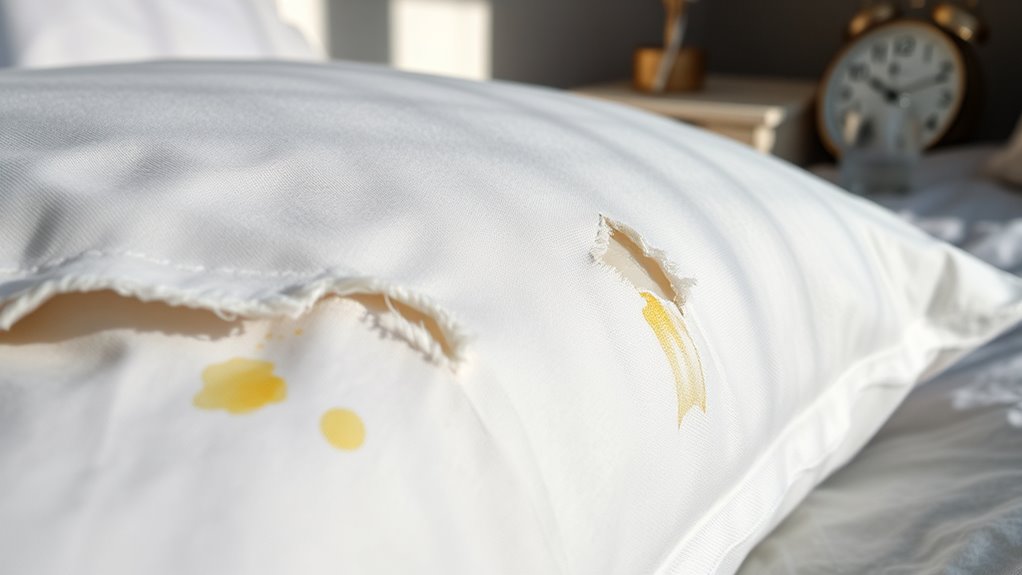
Your pillow wears out faster when you use it daily and sweat during sleep. Exposure to sunlight can also weaken the fabric and filling over time. These factors can substantially shorten your pillow’s lifespan if you’re not careful. Additionally, the materials used in some pillows may have vulnerabilities to material degradation caused by environmental conditions.
Daily Use and Sweat
Daily use and sweat considerably contribute to pillow wear and tear, especially when you sleep on the same surface night after night. Your body’s natural oils, sweat, and moisture break down the pillow’s materials over time, affecting pillow firmness and support. Your sleeping positions also influence how quickly your pillow deteriorates. To minimize this:
- Rotate your pillow regularly to distribute wear evenly.
- Use a pillow protector to shield against sweat and oils.
- Choose breathable materials that wick moisture away.
- Adjust your sleeping position to reduce uneven pressure on certain areas.
These actions help prolong your pillow’s lifespan, but even with care, daily use accelerates aging. Replacing your pillow every 1-2 years ensures better support and hygiene.
Exposure to Sunlight
Exposure to direct sunlight can considerably accelerate your pillow’s wear and tear. When your pillow is exposed to sunlight, the sunlight effects can cause fabrics and fillings to break down faster. Continuous pillow exposure to UV rays weakens the fibers, leading to fading, thinning, and loss of support. Over time, this deterioration makes your pillow less comfortable and less hygienic. Sunlight can also promote the growth of bacteria and mold, further degrading its quality. If you often leave your pillow in direct sunlight, you’ll notice it wears out more quickly than pillows kept in shaded areas. To extend your pillow’s lifespan, avoid prolonged pillow exposure to sunlight, especially during hot, sunny days. Protect your pillow from sunlight effects to maintain its support and cleanliness longer. Additionally, vetted camping gear such as portable tents and solar panels can help create shaded environments, reducing sunlight exposure and prolonging the life of your outdoor essentials.
Proper Pillow Maintenance for Longevity
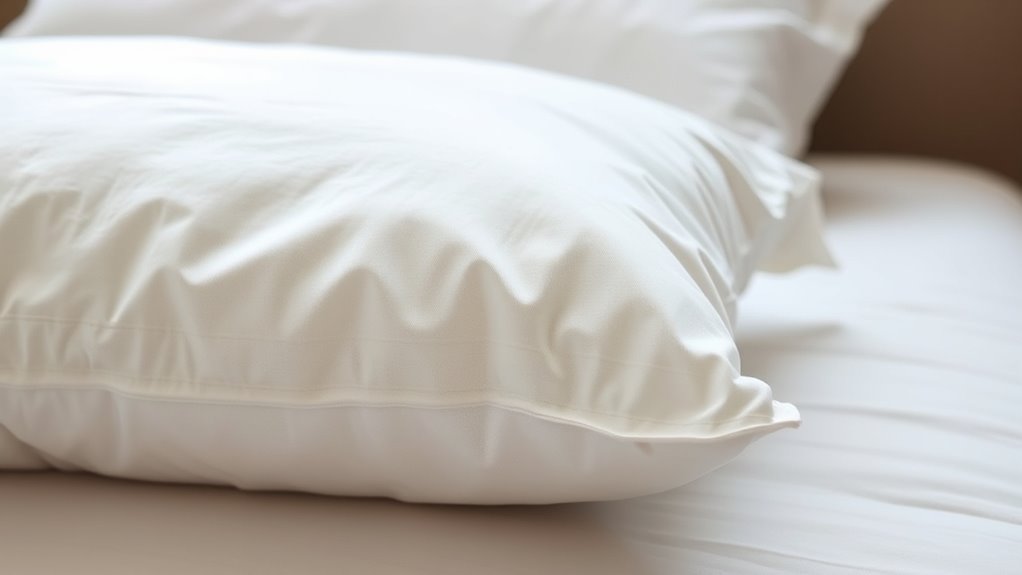
To guarantee your pillow lasts as long as possible, regular maintenance is essential. Proper care helps preserve its shape, support, and cleanliness. Here are four tips to maintain your pillow’s longevity:
- Wash regularly: Follow your pillow’s care instructions to keep it fresh and free of allergens.
- Protect with pillow covers: Use removable covers for easy cleaning and added protection.
- Adjust pillow customization: Change your pillow’s fill or firmness according to your sleep position to prevent uneven wear.
- Flip and fluff: Rotate and fluff your pillow daily to maintain shape and support.
- Be aware of pillow weight: Heavier pillows may require more careful handling during cleaning and replacement to avoid damage.
Choosing the Right Replacement Pillow for Your Sleep Needs
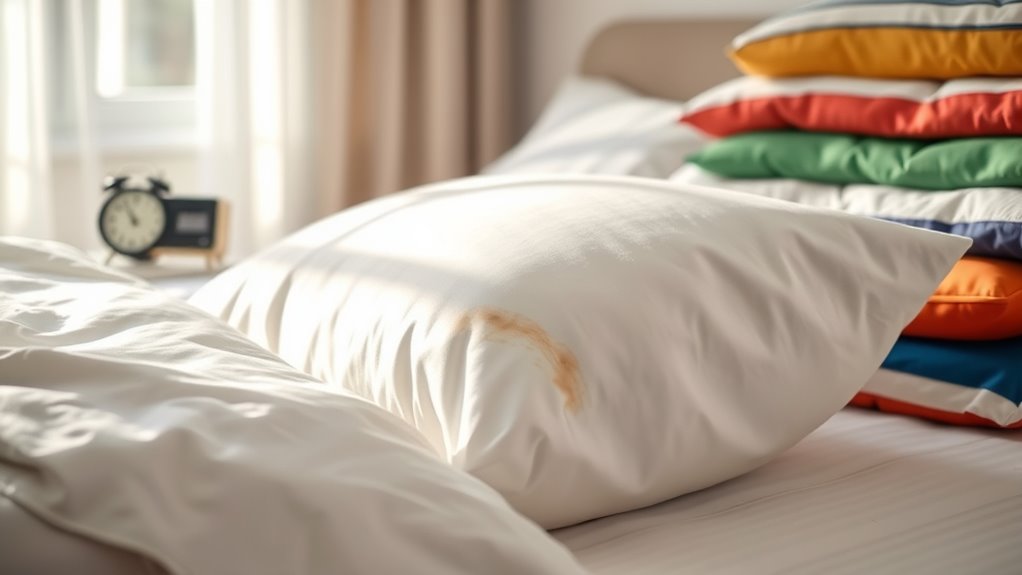
When selecting a new pillow, you need to find the right balance between support and comfort to suit your sleep style. Consider the materials to guarantee they match your allergies and preferences for a restful night. Making informed choices helps you wake up refreshed and free from discomfort. Additionally, understanding digital literacy can help you access resources for better sleep hygiene and overall wellness.
Support and Comfort Balance
Finding the right pillow means balancing support and comfort to suit your sleep needs. Your pillow’s firmness should complement your sleeping posture to reduce strain. Consider these factors:
- If you sleep on your back, opt for medium firmness to support your neck without raising your head too much.
- Side sleepers might need firmer pillows to fill the space between shoulder and head.
- Stomach sleepers should choose softer pillows to prevent neck strain and keep your head aligned.
- Adjust comfort by trying different densities until you find a balance that keeps your spine aligned and feels supportive yet cozy.
- Remember that pillow replacement is essential for maintaining proper support and hygiene, as over time, pillows can accumulate allergens and lose their supportive qualities.
Material and Allergies Compatibility
Choosing the right replacement pillow involves considering the materials it’s made from, especially if you have allergies or sensitivities. Material compatibility is key to preventing allergic reactions and ensuring comfort. Look for hypoallergenic options like memory foam, latex, or pillows with breathable covers made from natural fabrics such as cotton or bamboo. Avoid pillows with down feathers or synthetic fillings if you’re prone to allergies, as they can trap dust mites and allergens. Regularly replacing your pillow with one suited to your sensitivities helps maintain allergy prevention and promotes better sleep quality. Always check labels for allergen information and choose products designed to minimize allergy triggers. Prioritizing material compatibility ensures your pillow supports both your health and sleep needs effectively, especially when considering safety standards and regulations related to sleep products.
Tips for Maintaining a Clean Sleep Environment
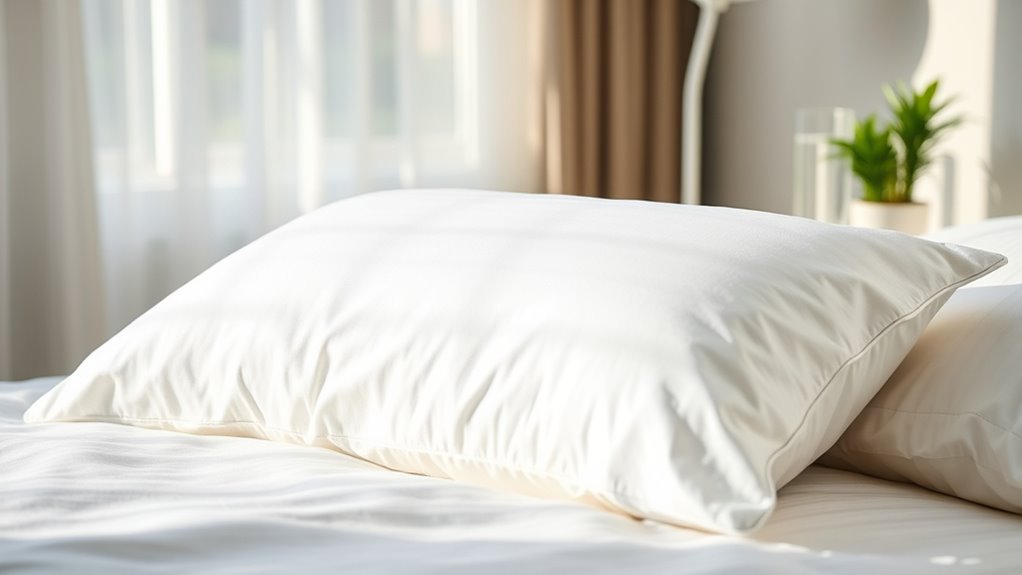
Maintaining a clean sleep environment is essential for your health and well-being. A tidy space reduces allergens and promotes restful sleep. Here are four tips to help:
A clean sleep space boosts health and restful nights by reducing allergens and dust buildup.
- Regularly wash your pillowcases to remove dirt and oils, especially if your pillow design involves delicate fabrics.
- Keep your bedding fresh by washing sheets weekly and using allergen-proof covers if needed.
- Adjust your sleep position to prevent excessive pressure on certain areas, which can trap dust and dirt.
- Vacuum your mattress and surrounding area to eliminate dust mites and debris that settle over time, especially since toilet maintenance and repairs can help prevent mold and bacteria buildup in the bedroom environment.
The Connection Between Pillow Hygiene and Overall Health
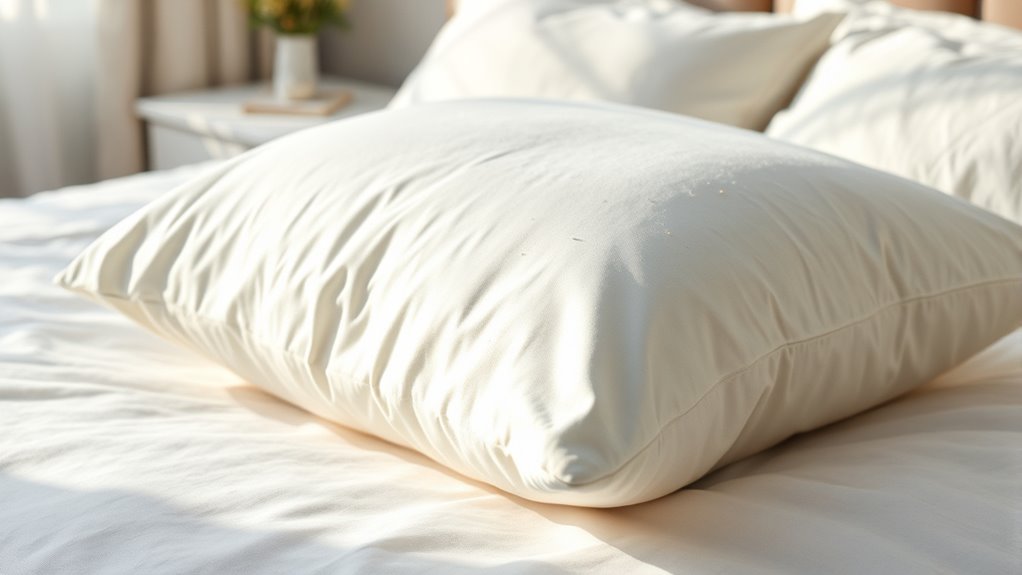
Because pillows can harbor bacteria, dust mites, and mold, your pillow hygiene directly impacts your overall health. Pillow allergens can trigger allergies and respiratory issues, especially if your sleep posture isn’t ideal. Poor hygiene allows these allergens to accumulate, leading to sneezing, congestion, or even asthma flare-ups. Maintaining a clean pillow reduces exposure to these irritants, promoting better breathing and sleep quality. Additionally, an unsanitary pillow can cause skin breakouts or infections. Ensuring your pillow stays fresh and replacing it when necessary helps support proper sleep posture, preventing neck and shoulder pain. Regularly inspecting and replacing your pillow can also prevent the buildup of preppy dog names and other allergens that may affect your health. Overall, good pillow hygiene isn’t just about comfort; it’s an essential step toward safeguarding your health and ensuring restful, restorative sleep.
Frequently Asked Questions
Can Using a Pillow Cover Extend My Pillow’S Lifespan?
Using a pillow cover helps maintain pillow hygiene and prevents dust mites from accumulating. It acts as a barrier against sweat, oils, and skin flakes that break down the pillow over time. By regularly changing and washing the cover, you extend your pillow’s lifespan and reduce allergy triggers. This simple step keeps your sleeping environment cleaner, healthier, and guarantees your pillow stays supportive and comfortable for longer.
How Do I Determine if My Pillow Is Causing Allergies?
To determine if your pillow is causing allergies, pay attention to your allergy symptoms like sneezing, congestion, or itchy eyes, especially after waking up. Poor pillow hygiene can harbor dust mites, mold, or allergens, triggering these reactions. Regularly washing and replacing your pillow helps reduce this risk. If symptoms persist despite good hygiene, consider replacing your pillow sooner and consulting an allergy specialist for personalized advice.
Are Memory Foam Pillows More Durable Than Traditional Ones?
Memory foam pillows are generally more durable than traditional pillows, thanks to their dense pillow material and resilience. While traditional pillows may flatten or lose support faster, the durability factors of memory foam keep their shape longer. You’ll find that memory foam provides lasting comfort, but it also depends on quality and usage. So, if you want a pillow that stands the test of time, memory foam is a smart choice.
What Are Eco-Friendly Options for Replacement Pillows?
When choosing eco-friendly replacement pillows, you look for options made from sustainable materials like organic cotton, bamboo, or recycled fibers. You also want to support eco-conscious brands committed to reducing environmental impact. These pillows not only help the planet but often offer comfort and durability. By selecting sustainable options, you guarantee a healthier sleep environment and contribute to a more sustainable future.
How Do Climate Conditions Affect Pillow Longevity?
Climate impact greatly influences your pillow’s lifespan, depending on your pillow materials. If you live in a humid area, moisture can promote mold and mildew, damaging your pillow faster. Conversely, dry climates may cause fillings to break down or clump. Temperature fluctuations can also affect pillow durability. To maximize longevity, choose materials suited for your climate, like moisture-wicking covers for humid zones or breathable fabrics for dry environments.
Conclusion
Think of your pillow as a trusty sidekick—eventually, even the best need a break. After all, just like you’d replace worn-out shoes to prevent discomfort, swapping your pillow every 1-2 years keeps your sleep fresh and healthy. I once ignored this rule, waking up with allergies and neck pain. Now, I change my pillow regularly, and sleep’s never been better. Don’t wait until your pillow’s story is told—refresh it for better nights ahead.


